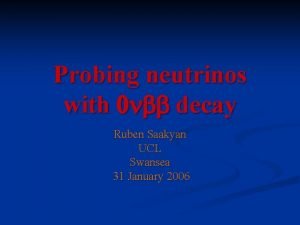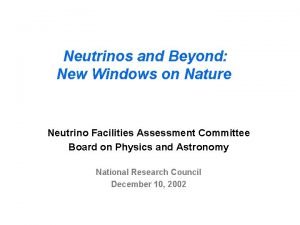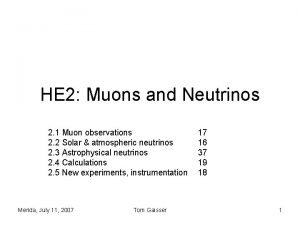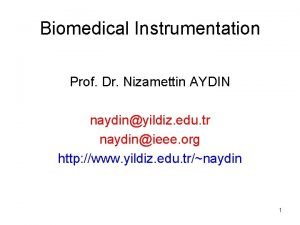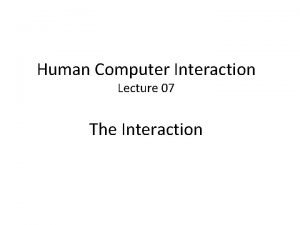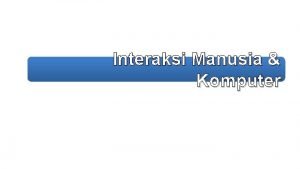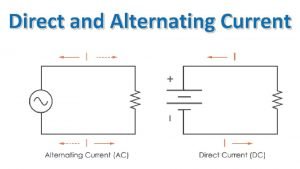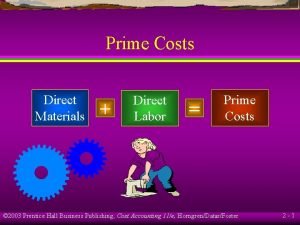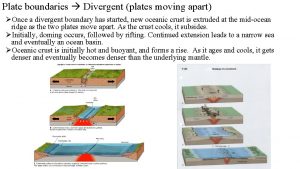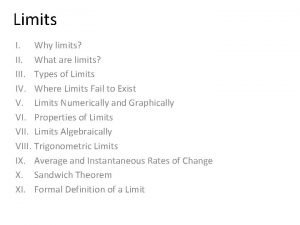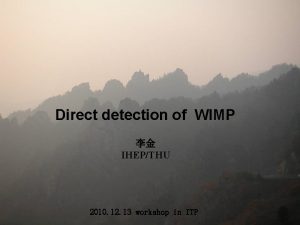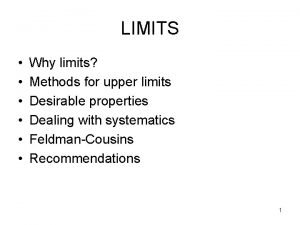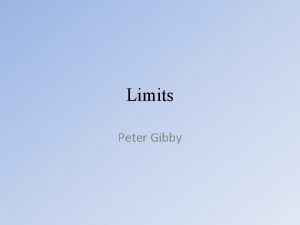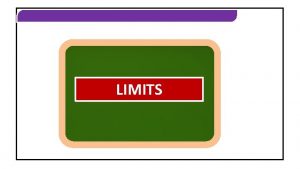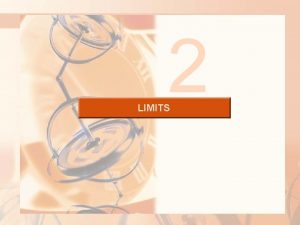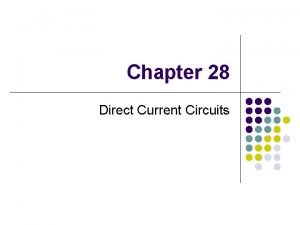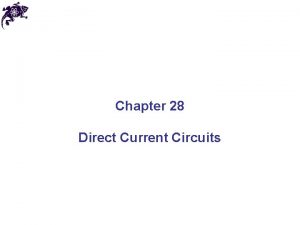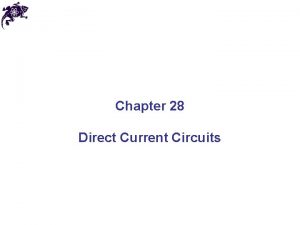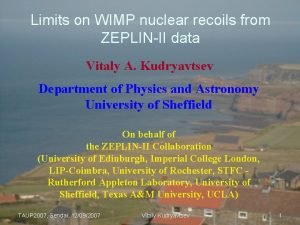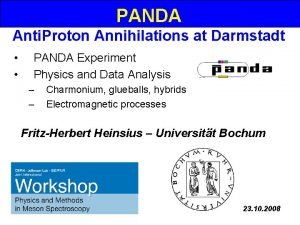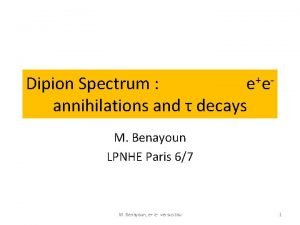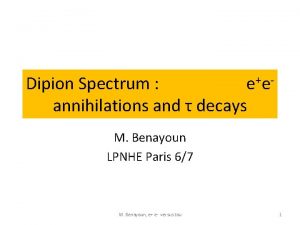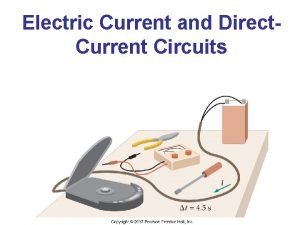Neutrinos from WIMP annihilations Current direct detection limits
































- Slides: 32

Neutrinos from WIMP annihilations Current direct detection limits and neutrino telescopes HENA Joakim Edsjö Stockholm University edsjo@physto. se Paris June 16, 2003

Outline • WIMPs as Dark Matter – Neutralinos in the MSSM • Current direct detection limits • Neutrino-induced muon fluxes – Basics – Uncertainties – Expected rates • Comparison with other rates • Conclusions

Relic density – simple approach Decoupling occurs when G < H We have Figure from Jungman, Kamionkowski and Griest, Phys. Rep. 267 (1996) 195.

MSSM – Mass spectrum The lightest neutralino is a good WIMP candidate.

The MSSM – parameters m M 2 m. A tan b values m 0 Ab At - Higgsino mass parameter Gaugino mass parameter mass of CP-odd Higgs boson ratio of Higgs vacuum expectation scalar mass parameter trilinear coupling, bottom sector trilinear coupling, top sector

Relic density – accurate approach Solve the Boltzmann equation – properly taking thermal average <·> – including the full annihilation cross section (all annihilation channels, thresholds, resonances). – including so called coannihilations between other SUSY particles present at freeze-out. Presently, all coannihilations between neutralinos, charginos and sfermions are included.

The MSSM – calculation flowchart The Lightest Supersymmetric Particle (LSP) Usually the neutralino. If R-parity is conserved, it is stable. The Neutralino – c Gaugino fraction 1. Select MSSM parameters 2. Calculate masses, etc 3. Check accelerator constraints 4. Calculate relic density 5. 0. 05 < Wch 2 < 0. 5 ? 6. Calculate fluxes, rates, . . . Calculation done with http: //www. physto. se/~edsjo/darksusy/

Relic density vs mass and composition The neutralino is cosmologically interesting for a wide range of masses and compositions!

The mc-Zg parameter space Gauginos Wh 2 > 1 Wh 2 < 0. 0 25 LE P Mixed Higgsinos Low sampling

WIMP search strategies • Direct detection • Indirect detection: – neutrinos from the Earth/Sun – antiprotons from the galactic halo – positrons from the galactic halo – gamma rays from external galaxies/halos – synchrotron radiation from the galactic center / galaxy clusters –. . .

Direct detection - general principles • WIMP + nucleus • Measure the nuclear recoil energy • Suppress backgrounds enough to be sensitive to a signal, or. . . • Search for an annual modulation due to the Earth’s motion around the Sun

Edelweiss June 2002 Most likely DAMA point. Excluded at 99. 8% CL + CDMS 2003 limits competitive at low masses

Direct detection – current limits Spin-independent scattering Spin-dependent scattering Direct detection experiments have started exploring the MSSM parameter space!

Neutralino capture and annihilation rc c Sun velocity distribution Earth n interactions sscatt nm n int. m int. Gcapture Gannihilation Detector interactions Silk, Olive and Srednicki, ’ 85 Gaisser, Steigman & Tilav, ’ 86 m hadronization Freese, ’ 86; Krauss, Srednicki & Wilczek, ’ 86 Gaisser, Steigman & Tilav, ’ 86

Neutrino telescopes – how do they work? • The neutrino scatters off a nucleus in the ice/water and creates a muon. • The muon emits Cherenkow radiation. • The radiation is detected by PM tubes from which the muon (neutrino) direction can be reconstructed.

Neutrino telescopes Capture and annihilation Evolution equation Capture Annihilation Evaporation (negligible) Solution Dependencies C – f(v), rc, sscatt, composition of Earth/Sun CA – sann, r(r) in Earth/Sun Note: Especially for the Earth, both f(v) and rc are rather uncertain as the Earth captures solar system WIMPs and not halo WIMPs.

Neutrino telescopes – Capture in Sun – Mostly on Hydrogen – Both spin-independent and spin-dependent scattering. Capture in Earth – Mostly on Iron – Essentially only spinindependent scattering. – Resonant scattering when the mass matches Iron. – Capture from solar-bound WIMPs (i. e. not directly from the halo) Figure from Jungman, Kamionkowski and Griest, Phys. Rep. 267 (1996) 195.

Capture by the Earth I • When halo WIMPs reach the Earth, they have gained speed by the Sun’s attraction • However, these halo WIMPs diffuse in the solar system by action of the other planets • The phase space density of these solar system WIMPs are the same as if the Earth was in free space.

Capture by the Earth II Bound orbits WIMP direction against Earth motion WIMP direction along Earth motion

Capture by the Earth III Filled orbits Mainly Jupiter, Venus and Earth will diffuse the WIMPs into orbits bound to the solar system.

Capture by the Earth IV • The low-velocity orbits are filled. • These are the ones that are most easily captured. • The phase space density is the same as if the Earth was in free space • Possible problems: perturbation of asteroids and validity of Gould approximations.

Capture by the Earth V Guess: No, the asteroid orbits are very special and in general WIMP orbits are not captured by the Sun. Guess: Yes, for all bound orbits, i. e. we capture only from unbound orbits • Problem: Asteroid simulations show that asteroids sling-shot out of the asteroid belt are perturbed and thrown into the Sun in about 100 000 years. • Is this true also for WIMP orbits? A. Gould and S. M. K. Alam, Ap. J 549 (2001) 72. Guess: Yes, but not for Jupiter crossing orbits since Jupiter fills bound orbits on short timescales

New population of WIMPs Damour & Krauss, ’ 98, ’ 99 Bergström, Damour, Edsjö, Krauss & Ullio, ’ 99 • WIMPs scatter in the outskirts of the Sun and end up in bound Sun-crossing orbits. • Venus and/or Jupiter perturb the orbit • Nearly radial orbits that do not cross the Sun, but do cross the Earth. • The Earth rates can increase by up to a factor of 10 for low-mass WIMPs.

Limits: m flux from the Earth/Sun Edelweiss excluded Earth Edelweiss excluded Sun • Super-K limit from Shantanu Desai’s idm 2002 talk, converted to full flux with 1 Ge. V threshold • Macro limit from Ivan de Mitri’s idm 2002 talk, converted to a Fm limit (hard spectrum, 1 Ge. V threshold) • Antares expected 3 yrs limits from Susan Cartwright’s idm 2002 talk (hard, conv. to 1 Ge. V threshold)

Flux from Earth/Sun and future direct detection limits Earth Future direct detection experiments (10 -9 pb at best mass). Sun Future direct detection experiments (10 -9 pb at best mass).

Comparing different searches • Take all future searches with expected sensitivities within the coming 5– 10 years. • Determine which areas in the mc-Zg parameter space they can explore. • Compare!

The mc-Zg parameter space Gauginos Wh 2 > 1 Wh 2 < 0. 0 25 LE P Mixed Higgsinos Low sampling

MSSM parameter space Future probed regions I Direct detection Genius/Cresst Earth, km 3 Sun, km 3

MSSM parameter space Future probed regions II Antiprotons gg Zg

MSSM parameter space All dark matter searches combined Large parts of the parameter space can be probed by future searches.

Conclusions • The neutralino is an excellent WIMP dark matter candidate. • Edelweiss excludes the DAMA claimed signal at 99. 8% CL. • Of the models allowed by Edelweiss, the neutrino-induced muon fluxes from the Earth are low, but from the Sun they can be high. • Be aware of the astrophysical uncertainties though: direct detection experiments are sensitive to the high-velocity part of the velocity distribution whereas neutrino telescopes are sensitive to the low-velocity part. • The rates from the Earth are affected by diffusion and solar capture uncertainties.

 Neutrinos
Neutrinos Windows on nature
Windows on nature Neutrinos
Neutrinos Shape 65
Shape 65 Lim as x approaches infinity
Lim as x approaches infinity Chassis leakage current
Chassis leakage current Nfpa 99 leakage current limits
Nfpa 99 leakage current limits Elements of hci
Elements of hci Model interaksi voluntary
Model interaksi voluntary Wimp adalah
Wimp adalah Paradigma wimp
Paradigma wimp Drift current and diffusion current
Drift current and diffusion current Ac systems lesson 4
Ac systems lesson 4 Infineon
Infineon Y connected generator
Y connected generator Kcl mesh analysis
Kcl mesh analysis Intrinsic semiconductor
Intrinsic semiconductor Diffusion current formula
Diffusion current formula Line current and phase current
Line current and phase current The constant current region of a fet lies between
The constant current region of a fet lies between Welding chapter 3 answers
Welding chapter 3 answers Drift current and diffusion current
Drift current and diffusion current In a triangle connected source feeding a y connected load
In a triangle connected source feeding a y connected load Hazard based safety engineering
Hazard based safety engineering Alternating current practice problems
Alternating current practice problems Graph of dc current
Graph of dc current Direct current transformer
Direct current transformer Direct material + direct labour
Direct material + direct labour Radiation dose limits
Radiation dose limits Moving apart
Moving apart Limits and continuity
Limits and continuity Susi postgraduate rates
Susi postgraduate rates Special trig limits
Special trig limits
